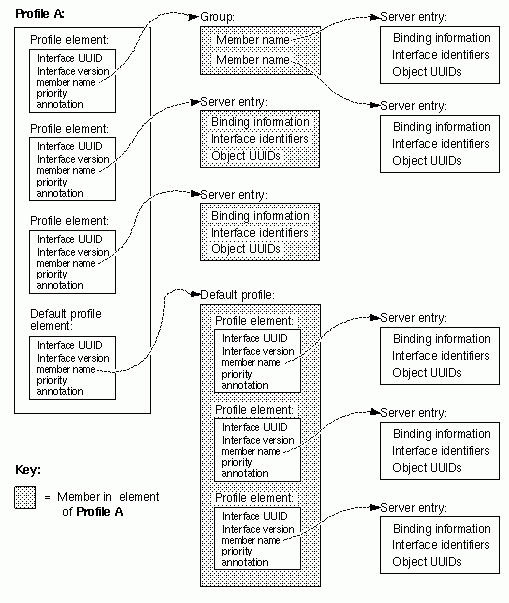
Administrators or users of RPC applications can organize searches of a namespace for binding information by having clients use an RPC profile as the starting point for NSI search operations. A profile is an entry in a namespace that contains a collection of profile elements. A profile element is a database record that corresponds to a single RPC interface and that refers to a server entry, group, or profile. Each profile element contains the following information:
· Interface identifier
This field is the key to the profile. The interface identifier consists of the interface UUID and the interface version numbers.
· Member name
The entry name of one of the following kinds of directory service entries:
- A server entry for a server offering the requested RPC interface
- A group corresponding to the requested RPC interface
- A profile
· Priority value
The priority value (0 is the highest priority; 7 is the lowest priority) is designated by the creator of a profile element to help determine the order for using the element NSI search operations to select among like-priority elements at random.
· Annotation string
The annotation string enables you to identify the purpose of the profile element. The annotation can be any textual information; for example, an interface name associated with the interface identifier or a description of a service or resource associated with a group.
Unlike the interface identifier field, the annotation string is not a search key.
Optionally, a profile can contain one default profile element. A default profile element is the element that an NSI search operation uses when a search using the other elements of a profile finds no compatible binding information; for example, when the current profile lacks any element corresponding to the requested interface. A default profile element contains the nil interface identifier, a priority of 0, the entry name of a default profile, and an optional annotation.
A default profile is a backup profile, referred to by a default profile element in another profile. A profile designated as a default profile should be a comprehensive profile maintained by an administrator for a major set of users, such as the members of an organization or the owners of computer accounts on a local area network (LAN).
A default profile must not create circular dependencies between profiles; for example, when a public profile refers to an application's profile, the application's profile must not specify that public profile as a default profile. The following figure shows an example of the kinds of elements a profile can contain and how those elements correspond to database entries.
Possible Mappings of a Profile

NSI search operations use a profile to construct an NSI search path. When an NSI search operation reads a profile, the operation dynamically constructs its NSI search path from the set of elements that correspond to a common RPC interface.
A profile element is used only once per NSI search path. The construction of NSI search paths depends partly on the priority rankings of the elements. A search operation uses higher-priority elements before lower-priority elements. Elements of equal priority are used in random order, permitting some variation in the NSI search paths between searches for a given interface. If nondefault profile elements do not satisfy a search, the search path extends to the default profile element, if any.
Profiles meet the needs of particular individuals, systems, LANs, sites, organizations, and so forth, with minimal configuration management. The administrator of a profile can set up NSI search paths that reflect the preferences of the profile's user or users. The profile administrator can set up profile elements that refer (directly or indirectly) to only a subset of the server entries that offer a given RPC interface. Also, the administrator can assign different search priorities to the elements for an interface.